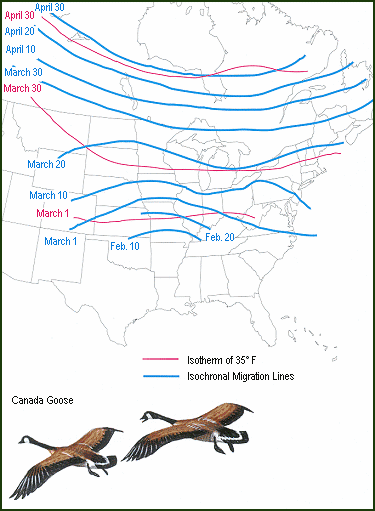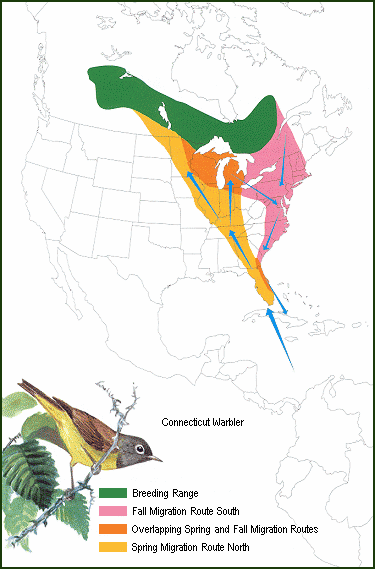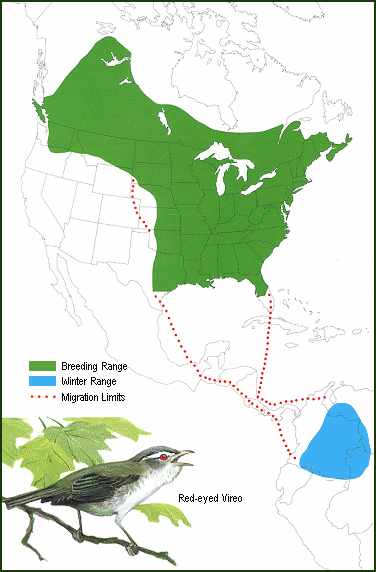Bird Migration
Information
FOR you ABOUT the birds
| So when did you first learn that birds migrated? It was probably very early on in your life. But how much do you really know about this fascinating natural phenomena? If you're curious enough to learn more, keep reading! Hopefully understanding more about the world around you will increase your appreciation for it, and maybe you'll pause just a little bit longer to contemplate the next time you see a bird fly overhead. |
Information
on this page was summarized from the information on the USGS website,
located at http://www.npwrc.usgs.gov/resource/othrdata/migratio/migratio.html
and based on the following source: Lincoln, Frederick C., Steven R. Peterson, and John L. Zimmerman. 1998. Migration of birds. U.S. Department of the Interior, US Fish and Wildlife Service, Washington, D.C. Circular 16. 113pp. |

So tell me something...
People have tried to figure out the habits of our fine feathered friends for thousands of years. The Greek Aristotle used to think that birds actually changed from one species to another when they changed their plumage from summer to winter. He wasn't the only one with crazy ideas; people used to think that birds hibernated! In 1703, a "person of learning and piety" suggested in a pamphlet that birds flew to the moon and wintered there. When people finally began to believe birds migrated, they thought larger birds would carry the smaller ones on their backs. Looking back, some pretty wild ideas were flying around.
Then how do you study migration?
There are many ways to study migration, and the following are only some of them. Direct observation, whether at night or during the day, is a time honored classic that's good for the amateur as the pro. A little more complicated way is using an aural amplifier, which will amplify bird calls and give an idea of species and numbers. Many natural history museums look at when and where their preserved specimens were collected to get an idea of bird habits. A great deal of information can be learned if birds can be caught, marked, and released without harm. Radio tracking attaches is a small transmitter to the bird that occasionally "beeps" for the observer to track the movements. Bird movements can even be studied using RADAR!
If you want a first hand chance to study migration, start by checking out the birds on campus or where you live. You can also go to Hawk Mountain Sanctuary (http://www.hawkmountain.org/default.shtml) to join them on bird walks or to observe birds on your own. It's a great place to spend the day hiking!
So... why do they do it?
150 million years ago birds separated from reptiles in the fossil record, and the changing climates since 100 million years gave rise to the evolution of a diversity of species with different migration habits that change and develop as climate, geography, and species numbers continue to change. A major benefit of migration is the ability to inhabit two regions, each in a time when survival conditions are favorable. Not all species are migratory, and some species are only partially migratory. Migrants are physically adapted to make the trip. Birds require specific environmental conditions such as food availability and nesting resources to breed. Migration has evolved to take full advantage of these environmental conditions, and environment is key to migratory timing.
How fast do they fly and what's the rate of migration?
Birds in general fly at various speeds, and for a substantial flight large birds on average fly faster than small birds. Over the entire bird world the average flight speeds range from 20-50 mph. A peregrine on a stoop (dive towards prey) is estimated to exceed 100 mph (the fastest moving animal on earth). On migration, flight is not at speeds used to catch prey or escape predators, but impressive distances are still covered. A 10 hour flight carries most migrants 100-250 miles. Waterfowl may cover 400-500 miles in the same time period. Birds are clocked in migration by radar to be moving about 30 mph for songbirds and 45 for shorebirds. Much of the speed of migration depends on wind conditions and some birds slow down to conserve energy when they are aided by wind. Bird banding has produced some extraordinary examples of individual flights. A Lesser Yellowlegs banded on Cape Cod, for example, was found in the West Indies only 6 days later. Other facts can also influence the speeds birds use on migration. A Canada goose, for example, only migrates north as fast as the advancing spring allows for 35-degree temperatures. Others birds wait until spring is advanced and then rush to breeding grounds, often passing other species that have been en route for up to a month.
How high do they fly?
Since migrating
at height has advantages of surmounting barriers, spotting landmarks,
catching winds, etc. some birds fly at incredible heights. While nearly
all migratory flights are under 10,000 ft, and most of these under 3000,
some exceptional flights have been observed (although most data are
not exact.) Some reliable figures are a Mallard Duck that was struck
by an airliner at 21,000 feet! On the other extreme some birds such
as sea ducks fly so low they can only be see when they rise above the
level of the waves.
Do they all fly together?
On migration
birds can be observed traveling in mixed species flocks; some do so
due to simple biological similarity. Migrants may also flock with other
migrants or with non-migrants in order to gain better protection from
predators. This allows them to hide among other birds and share in the
advantage of many more wary eyes. Birds like geese and cormorants also
group to gain an aerodynamic flight advantage. Some species, by abandoning
young, migrate before or after the young birds; hence a group of migrants
may be all adults or immature based on timing and species. Other birds
like geese fly in family units of mixed ages. Some species may also
segregate according to sex in migration with one sex migrating sooner
or later than the other, usually depending upon parental roles.
What about geographic patterns?
Some birds like a Northern Cardinal may never leave 10 miles of where they were born. Others have small migrations that are often undetected because the local populations moving south are replaced by northern individuals. This happens in much of the range of the American Robin and is part of the reason that they are not a good "harbinger of spring". Of all land birds seen in the Lehigh area the champion migrant is the Barn Swallow. This bird can be found in summer as far north as Yukon Territory and as far South in winter as Argentina, a journey of 7,000 miles! The world record for migration distance, however, still belongs to the Arctic Tern which migrates from the arctic circle to the Antarctic every year, spending about 8 months of the year en route. Some of the routes used by North American birds moving into South America are shown below.

What about orientation and navigation?
Birds use a variety of navigational techniques. Scientists agree that migratory habits evolved independently for different birds so no one understanding of migrations fits all birds. Studies done by moving birds to other areas have shown that some birds can recognize they have been moved and fly to their traditional migration routes despite this. Other birds fly in the same general direction of migration when moved, but do not return to original pathway. Individual birds that have made migrations before can use landmarks, this method is used mostly by birds that migrate in family groups. Other birds have been shown to use the orientation of the stars, the sun, or even geomagnetism. Other less studied possibilities include the use of prevailing wind patterns or even sense of smell.
How do they prepare?
There's actually a biological spring pre-migratory response. It causes them to overeat, thereby gaining weight at an astonishing rate, but this is good because the stored fat is crucial for long migrations. Most birds migrate during the night, and they starting getting more nocturnal as the time to migrate approaches. Birds also react to light and temperature, using all these factors to know when to migrate. Free pre-migratory responses are more of a mystery. One theory says that spring migration starts an internal "timer" that tells birds when to return to winter homes, but this has yet to be proved.
Are they influenced by weather and topography?
Temperatures can accelerate or delay when a migration will begin. As seen in the Canada Goose's migration (below) many birds have a temperature sensitive movement where they will migrate only as fast as the spring warms northward. Prevailing winds, however, are probably the most important factor. Because of this migrants can be seen grouped along weather fronts that produce favorable weather conditions. Soaring birds like hawks also rely on heating of the earth to produce the “thermals” of rising air they ride to save energy. Thus a clear day with correct winds will be a day for migration of soaring birds.

Birds can often soar above even the highest peaks but despite this they are often influenced by topography. In some cases topographic features are used as landmarks for migrations. Other features such as lakes and oceans prevent problems for birds. Birds that do not hunt by water must make often large water crossings in one leap without feeding. Other birds which rely of thermals will also have trouble gapping these features as water does not produce the quick heating required for thermal rise. Because of this, migrating hawks and other soaring birds will concentrate along shorelines in their passage south.
Is migration safe?
Migration's actually a risky maneuver. Thousands of small migrants die every year from predators or other hazards. Aerial obstructions such as telephone towers, tall buildings, and lighthouses are one reason for the high mortality rates. Storms can be very dangerous as well. Fighting high winds is the main reason that migrating birds face exhaustion; otherwise they can fly surprisingly long distances with only a minimal fat intake. Cool Trivia: The American Golden-Plover can travel an amazing 2,400-mile oceanic route in 48 hours of continuous flight! Wow!
Where do they go?
First of all, it's important to remember that "migration route" is just a generalized term for the general seasonal movement of the species rather than a carefully and exactly marked road in the sky. Species routes show considerable variation.
How do they do it?
Birds, like people, travel in a variety of ways. Species that travel in loops do not use the same routes in the spring and fall; rather they make a circuit of travel. Unrelated species utilize this method of migration, and one reason might be necessity due to present environmental resources. An example is the Connecticut Warbler.

Another type of migratory route is dog-legs. These have a clear bend in the route, and studies have shown this might have developed from when the destinations changed but the species continued to follow old routes even if they were no longer direct. This is clearly seen in the migration of the Red-eyed Vireo.

A third type of migration is pelagic wandering. Many pelagic birds off the coast engage in nomadic wanderings while not breeding. There is a seasonal shift to indicate these are not random movements. An observation of these birds is difficult and thus good records are few. Other birds' migration habits are known as leap-frogging. When two species breed and winter along the same axis, the bird that breeds farther north usually winters farthest south and in effect "leap frogs" over the other species. The fifth type of migration discussed is vertical migration. Some birds are able to merely migrate hundreds of miles down a mountain, a distance which corresponds to a shift in latitude.
There are many
other types of migration, and two that don't fit the established scheme
are as follows. Recent studies have looked in the pre-migratory
movements of some birds and found that they have a tendency
to disperse early in life. These are not true migrations though they
are journeys between the breeding ground and another area; they usually
involve only one age group and not the entire population. Vagrant
migrants sometimes stage mass periodic invasions far outside
their normal territories, the Snowy Owl for one.
So what's next?
Though scientists have learned a lot about bird migration, there is still much more to learn. Humans are challenged to learn more about the world around them, their effects upon the environment, and the best ways to care for all aspects of the world. How will you become a steward of the Earth in the years to come?